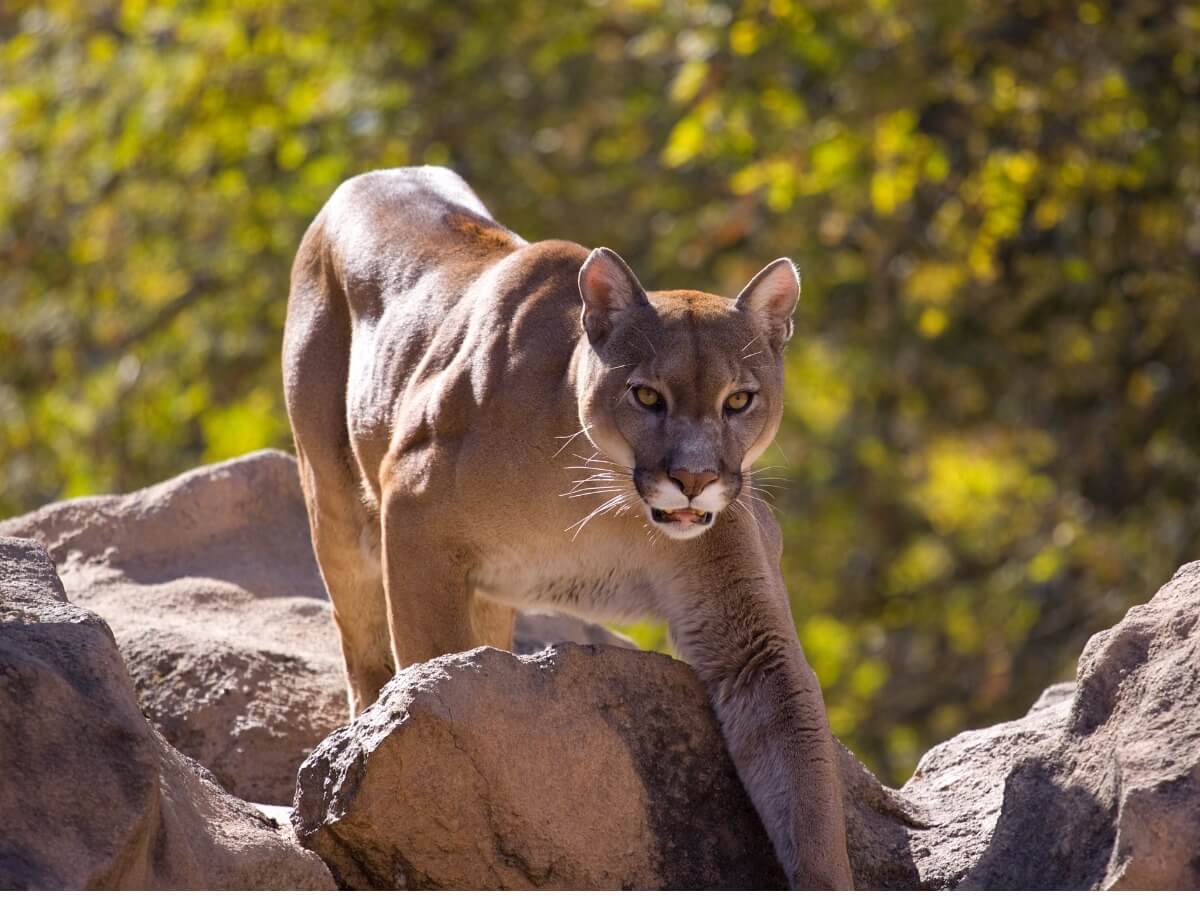What Do Pumas Eat and How Do They Hunt?

Out of all the feline family, the puma is one of the most feared by man since time immemorial. Its stealth and incredible strength allow it to catch prey much larger than itself, so it isn’t an animal you would want to come face to face with. Find out all about what pumas eat and how they hunt in this article.
In this article, you’ll be able to delve into pumas’ eating and hunting habits from the safety of your own home. It’s also worth noting that studying the hunting habits of this species is crucial to its conservation, so don’t miss it.
Puma characteristics
The puma, also known as the mountain lion or American lion, is a carnivorous mammal of the Felidae family, native to the Americas. Its habitat extends across a wide variety of biomes throughout this continent, as it’s an animal that adapts easily and is a generalist.
Although larger than some big cats, it actually shares more characteristics with the smaller ones, such as the ability to purr.
Currently, two main subspecies of puma are recognized compared to the 32 that were identified at the end of the 20th century. They are the following:
- Puma concolor concolor, or South American puma: This subspecies populates all of South America, especially in the southern Andes region. Later on in the article we’ll explain how this subspecies has other related subspecies.
- The cougar (puma concolor): This subspecies lives in North America and Central America.

What pumas eat
The puma is a strictly carnivorous feline. It’s a primary predator, which means that its purpose in the food chain is to just feed on herbivores.
Its favorite prey are large ungulates and camelids, but it can also feed on small mammals and birds that come within its reach. These generalist habits are what guarantee its survival, since in its habitat it competes against other large predators, such as the jaguar or the grizzly bear.
In one year, a single puma consumes about 860-1300 kilograms (1900 to 2900 pounds) of meat, which corresponds to about 48 ungulates and other animals.
The puma stalks its prey hidden among tall grass or rocky ledges, waiting for the right moment to ambush it. When it’s a large animal (such as a deer), the only way to bring it down is to grab its neck with its fangs, pressing on its windpipe and killing it by suffocation and exsanguination.
When it succeeds in hunting large animals, the puma drags them to safety before eating them. It can travel almost a kilometer (0.6 miles) to find an optimal spot.
Prey and eating habits vary according to the region where the puma lives. Therefore, in the following sections, we’ll bring you more specific information about each geographical area.
What pumas eat in North America
In this region, we can see the subspecies commonly known as the cougar. Its diet consists of 68% of large animals, including white-tailed deer, mule deer, and elk. In the southernmost part of America, near Florida, these prey are supplemented by wild boar and armadillos.
Puma diet in Central America
In Central America, pumas eat smaller prey. Ungulates, which are less common, make up only 35% of its diet here. In these regions, it feeds mainly on large rodents, such as capybaras and porcupines, small vertebrates, and lagomorphs.
Puma diet in South America
In South America, this species is much more widespread. This is why several subspecies have been recognized (as we explained earlier) all of which are synonymous with the subspecies Puma concolor concolor:
- Northern South American cougar, Puma concolor concolor.
- Eastern South American cougar, Puma concolor anthony.
- Puma of southern South America, Puma concolor puma.
- Argentine cougar, Puma concolor cabrerae.
This is where the puma faces the most competition from other carnivores and where large prey is most scarce. Therefore, in these regions it feeds on smaller animals and does it more frequently. Preferred prey include deer, coatis, and birds.
The importance of puma conservation
The puma, like all large carnivores, plays an important role in its ecosystem. Studies on their feeding habits have shown that the presence of pumas is an indicator of the good quality of the biome, as they inhabit areas where there’s abundant prey.
On the other hand, it’s a species whose density of population is very low, but has a very extensive distribution. This means that when a single puma dies, it affects the balance in a large area.
Currently, this species has a vulnerable status (VU). The greatest threats it faces are illegal hunting and habitat destruction. In addition, in areas of North America where they’re forced to feed on livestock, these animals are being affected by the distemper virus, present in dogs in the area.
As you can see, all levels of the food chain are necessary for the proper balance of any given ecosystem. Although no one would like to come face to face with a puma on their travels, recognizing their right to life means that we’re contributing to the life cycle in many different ecosystems.
Out of all the feline family, the puma is one of the most feared by man since time immemorial. Its stealth and incredible strength allow it to catch prey much larger than itself, so it isn’t an animal you would want to come face to face with. Find out all about what pumas eat and how they hunt in this article.
In this article, you’ll be able to delve into pumas’ eating and hunting habits from the safety of your own home. It’s also worth noting that studying the hunting habits of this species is crucial to its conservation, so don’t miss it.
Puma characteristics
The puma, also known as the mountain lion or American lion, is a carnivorous mammal of the Felidae family, native to the Americas. Its habitat extends across a wide variety of biomes throughout this continent, as it’s an animal that adapts easily and is a generalist.
Although larger than some big cats, it actually shares more characteristics with the smaller ones, such as the ability to purr.
Currently, two main subspecies of puma are recognized compared to the 32 that were identified at the end of the 20th century. They are the following:
- Puma concolor concolor, or South American puma: This subspecies populates all of South America, especially in the southern Andes region. Later on in the article we’ll explain how this subspecies has other related subspecies.
- The cougar (puma concolor): This subspecies lives in North America and Central America.

What pumas eat
The puma is a strictly carnivorous feline. It’s a primary predator, which means that its purpose in the food chain is to just feed on herbivores.
Its favorite prey are large ungulates and camelids, but it can also feed on small mammals and birds that come within its reach. These generalist habits are what guarantee its survival, since in its habitat it competes against other large predators, such as the jaguar or the grizzly bear.
In one year, a single puma consumes about 860-1300 kilograms (1900 to 2900 pounds) of meat, which corresponds to about 48 ungulates and other animals.
The puma stalks its prey hidden among tall grass or rocky ledges, waiting for the right moment to ambush it. When it’s a large animal (such as a deer), the only way to bring it down is to grab its neck with its fangs, pressing on its windpipe and killing it by suffocation and exsanguination.
When it succeeds in hunting large animals, the puma drags them to safety before eating them. It can travel almost a kilometer (0.6 miles) to find an optimal spot.
Prey and eating habits vary according to the region where the puma lives. Therefore, in the following sections, we’ll bring you more specific information about each geographical area.
What pumas eat in North America
In this region, we can see the subspecies commonly known as the cougar. Its diet consists of 68% of large animals, including white-tailed deer, mule deer, and elk. In the southernmost part of America, near Florida, these prey are supplemented by wild boar and armadillos.
Puma diet in Central America
In Central America, pumas eat smaller prey. Ungulates, which are less common, make up only 35% of its diet here. In these regions, it feeds mainly on large rodents, such as capybaras and porcupines, small vertebrates, and lagomorphs.
Puma diet in South America
In South America, this species is much more widespread. This is why several subspecies have been recognized (as we explained earlier) all of which are synonymous with the subspecies Puma concolor concolor:
- Northern South American cougar, Puma concolor concolor.
- Eastern South American cougar, Puma concolor anthony.
- Puma of southern South America, Puma concolor puma.
- Argentine cougar, Puma concolor cabrerae.
This is where the puma faces the most competition from other carnivores and where large prey is most scarce. Therefore, in these regions it feeds on smaller animals and does it more frequently. Preferred prey include deer, coatis, and birds.
The importance of puma conservation
The puma, like all large carnivores, plays an important role in its ecosystem. Studies on their feeding habits have shown that the presence of pumas is an indicator of the good quality of the biome, as they inhabit areas where there’s abundant prey.
On the other hand, it’s a species whose density of population is very low, but has a very extensive distribution. This means that when a single puma dies, it affects the balance in a large area.
Currently, this species has a vulnerable status (VU). The greatest threats it faces are illegal hunting and habitat destruction. In addition, in areas of North America where they’re forced to feed on livestock, these animals are being affected by the distemper virus, present in dogs in the area.
As you can see, all levels of the food chain are necessary for the proper balance of any given ecosystem. Although no one would like to come face to face with a puma on their travels, recognizing their right to life means that we’re contributing to the life cycle in many different ecosystems.
All cited sources were thoroughly reviewed by our team to ensure their quality, reliability, currency, and validity. The bibliography of this article was considered reliable and of academic or scientific accuracy.
- Nielsen, C., Thompson, D., Kelly, M. & Lopez-Gonzalez, C.A. 2015. Puma concolor (errata version published in 2016). The IUCN Red List of Threatened Species 2015: e.T18868A97216466. https://dx.doi.org/10.2305/IUCN.UK.2015-4.RLTS.T18868A50663436.en. Downloaded on 11 November 2021.
- Hernández-Guzmán, A., Payán, E., & Monroy-Vilchis, O. (2011). Hábitos alimentarios del Puma concolor (Carnivora: Felidae) en el Parque Nacional Natural Puracé, Colombia. Revista de Biología Tropical, 59(3), 1285-1294.
- Puma concolor (cougar). (s. f.). Animal Diversity Web. Recuperado 11 de noviembre de 2021, de https://animaldiversity.org/accounts/Puma_concolor/
This text is provided for informational purposes only and does not replace consultation with a professional. If in doubt, consult your specialist.








